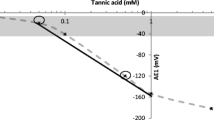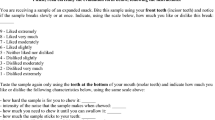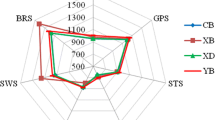Abstract
A quantitative analysis of perceived saltiness was established by combining sensory perceived NaCl concentration with electronic tongue salty response. Saltiness index (SI) was defined as the ratio of perceived NaCl concentration to the actual NaCl concentration, and was proposed to evaluate the saltiness enchantment. Method validation of the saltiness sensor included assessments of linearity, repeatability, reproducibility, limit of detection, limit of quantitation, and recovery yield. A desirable linear relationship between the logarithm of perceived NaCl concentration and saltiness was observed at NaCl concentration ranging from 45 to 90 mM with a determination coefficient exceeding 0.99. A low relative standard deviation of less than 1% was achieved in the repeatability test. Through visual evaluation, the detection and quantitation limits of the saltiness sensor for NaCl solutions were determined to be 0.01 mM and 0.1 mM, respectively. A high recovery yield (97.6–108.3%) was obtained from the spike recovery test. Optional test solvents, including ultrapure water, distilled water, and pure water, were employed without interference. Upon adding 20–35 g/100 g potassium chloride, the salty response of the salt solution increased, while the linearity of NaCl solution remained unaffected. Saltiness enhancements of 37.20 ± 0.00% and 18.17 ± 0.18% were observed for the potassium-containing salt (30%, w/w) and oyster mushroom (Pleurotus ostreatus) peptides (0.3%, w/w), respectively. This evaluation method provided an effective and quantitative approach to advancing the development of salt reduction ingredients.




Similar content being viewed by others
Data Availability
No datasets were generated or analysed during the current study.
References
Albarracín W, Sánchez IC, Grau R, Barat JM (2011) Salt in food processing; usage and reduction: a review. Int J Food Sci Technol 46(7):1329–1336. https://doi.org/10.1111/j.1365-2621.2010.02492.x
AOAC International (2016) Guidelines for standard method performance requirements. Appendix F. Association of Official Analytical Chemist, Rockville, MD, USA
Araujo P (2009) Key aspects of analytical method validation and linearity evaluation. J Chromatogr B-Analytical Technol Biomedical Life Sci 877(23):2224–2234. https://doi.org/10.1016/j.jchromb.2008.09.030
Cerón-Guevara MI, Rangel-Vargas E, Lorenzo JM, Bermúdez R, Pateiro M, Rodríguez JA, Sánchez-Ortega I, Santos EM (2020) Reduction of salt and fat in frankfurter sausages by addition of Agaricus Bisporus and Pleurotus ostreatus flour. Foods 9(6):760. https://doi.org/10.3390/foods9060760
Cetó X, Céspedes F, Pividori MI, Gutiérrez JM, del Valle M (2012) Resolution of phenolic antioxidant mixtures employing a voltammetric bio-electronic tongue. Analyst 137(2):349–356. https://doi.org/10.1039/C1AN15456G
Civille GV, Carr BT (2015) Chapter 10 - Selection and Trainingof Panel Members. Sensory Evaluation Techniques (5th Edition) (pp. 165–200): CRC Press
Deisingh AK, Stone DC, Thompson M (2004) Applications of electronic noses and tongues in food analysis. Int J Food Sci Technol 39(6):587–604. https://doi.org/10.1111/j.1365-2621.2004.00821.x
dos Santos JM, de Andrade JK, Galvão F, Felsner ML (2019) Optimization and validation of ultrasound-assisted extraction for the determination of micro and macro minerals in non-centrifugal sugar by F AAS. Food Chem 292(15):66–74. https://doi.org/10.1016/j.foodchem.2019.04.037
Eckert C, Lutz C, Breitkreutz J, Woertz K (2011) Quality control of oral herbal products by an electronic tongue-case study on sage lozenges. Sens Actuators B-Chemical 156(1):204–212. https://doi.org/10.1016/j.snb.2011.04.018
Escuder-Gilabert L, Peris M (2010) Review: highlights in recent applications of electronic tongues in food analysis. Anal Chim Acta 665(1):15–25. https://doi.org/10.1016/j.aca.2010.03.017
Fagundes GA, Benedetti S, Pagani MA, Fiorentini AM, Severo J, Salas-Mellado M (2022) Electronic sensory assessment of bread enriched with cobia (Rachycentron canadum). J Food Process Eng 45(7):1–6. https://doi.org/10.1111/jfpe.13656
GBD 2019 Risk Factors Collaborators (2020) Global burden of 87 risk factors in 204 countries and territories, 1990–2019: a systematic analysis for the global burden of Disease Study 2019. Lancet 396(10258):1223–1249. https://doi.org/10.1016/s0140-6736(20)30752-2
Gustavo Gonzalez A, Angeles Herrador M, Asuero AG (2010) Intra-laboratory assessment of method accuracy (trueness and precision) by using validation standards. Talanta 82(5):1995–1998. https://doi.org/10.1016/j.talanta.2010.07.071
He FJ, Campbell NRC, Woodward M, MacGregor GA (2021) Salt reduction to prevent hypertension: the reasons of the controversy. Eur Heart J 42(25):2501–2505. https://doi.org/10.1093/eurheartj/ehab274
Henriques J, Schaberle FA, Serpa C, Pais AACC, Cardoso C, Vitorino C (2021) Photoacoustic method for real-time assessment of salt content in aqueous solutions. Talanta 222:121497. https://doi.org/10.1016/j.talanta.2020.121497
ICH harmonized tripartite guideline (2005) : validation of analytical procedures: text and methodology Q2(R1), International Conference of harmonization of technical requirements for registration of pharmaceuticals for human use
Iwaniak A, Minkiewicz P, Darewicz M, Hrynkiewicz M (2016) Food protein-originating peptides as tastants - physiological, technological, sensory, and bioinformatic approaches. Food Res Int 89:27–38. https://doi.org/10.1016/j.foodres.2016.08.010
Jiang H, Zhang M, Bhandari B, Adhikari B (2018) Application of electronic tongue for fresh foods quality evaluation: a review. Food Reviews Int 34(8):746–769. https://doi.org/10.1080/87559129.2018.1424184
Kurtz TW, DiCarlo SE, Pravenec M, Morris RC Jr. (2018) The pivotal role of renal vasodysfunction in salt sensitivity and the initiation of salt-induced hypertension. Curr Opin Nephrol Hypertens 27(2):83–92. https://doi.org/10.1097/mnh.0000000000000394
Latha RS, Lakshmi PK (2012) Electronic tongue: an analytical gustatory tool. J Adv Pharm Tech Res 3(1):3–8. https://doi.org/10.4103/2231-4040.93556
Li X, Xie X, Wang J, Xu Y, Yi S, Zhu W, Mi H, Li T, Li J (2020) Identification, taste characteristics and molecular docking study of novel umami peptides derived from the aqueous extract of the clam meretrix meretrix Linnaeus. Food Chem 312:126053. https://doi.org/10.1016/j.foodchem.2019.126053
Marx ÍMG, Veloso ACA, Casal S, Pereira JA, Peres AM (2021) Chapter 12 - sensory analysis using electronic tongues. In: Galanakis CM (ed) Innovative food analysis. Academic, pp 323–343
Mattar TV, Gonçalves CS, Pereira RC, Faria MA, de Souza VR, Carneiro J (2018) d. D. S. A shiitake mushroom extract as a viable alternative to NaCl for a reduction in sodium in beef burgers. British Food Journal, 120(6), 1366–1380. https://doi.org/10.1108/BFJ-05-2017-0265
MoH of China (2011) Ministry of Health of the People’s Republic of China, GB 26878–2011. Iodine content in edible salt [S]
MoH of China (2016a) Ministry of Health of the People’s Republic of China, GB 5009.44–2016. Determination of chlorides in foods [S]
MoH of China (2016b) Ministry of Health of the People’s Republic of China, GB/T 5461–2016. Edible salt [S]
MoH of China (2014) Ministry of Health of the people’s Republic of China, GB 2760–2014. Standards for uses of food additive [S]
Moore A, Luckett CR, Munafo JP Jr. (2021) Taste-active dipeptides from hydrolyzed mushroom protein enhance saltiness. J Agric Food Chem 69(40):11947–11959. https://doi.org/10.1021/acs.jafc.1c04479
Pein M, Eckert C, Preis M, Breitkreutz J (2013) New protocol for αAstree electronic tongue enabling full performance qualification according to ICH Q2. J Pharm Biomed Anal 83:157–163. https://doi.org/10.1016/j.jpba.2013.05.005
Regueiro J, Negreira N, Simal-Gandara J (2017) Challenges in relating concentrations of aromas and tastes with flavor features of foods. Crit Rev Food Sci Nutr 57(10):2112–2127. https://doi.org/10.1080/10408398.2015.1048775
Schindler A, Dunkel A, Staehler F, Backes M, Ley J, Meyerhof W, Hofmann T (2011) Discovery of salt taste enhancing arginyl dipeptides in protein digests and fermented fish sauces by means of a sensomics approach. J Agric Food Chem 59(23):12578–12588. https://doi.org/10.1021/jf2041593
Shen D, Pan F, Yang Z, Song H, Zou T, Xiong J, Li K, Li P, Hu N, Xue D (2022) Identification of novel saltiness-enhancing peptides from yeast extract and their mechanism of action for transmembrane channel-like 4 (TMC4) protein through experimental and integrated computational modeling. Food Chem 388:132993. https://doi.org/10.1016/j.foodchem.2022.132993
Su T, Chen Y, Liu H, Gao Y, Guo J, Li Y, Qi Y, Qiu L (2022) The biosynthesis of 1-octene-3-ol by a multifunctional fatty acid dioxygenase and hydroperoxide lyase in Agaricus Bisporus. J Fungi 8(8):827–838. https://doi.org/10.3390/jof8080827
Woertz K, Tissen C, Kleinebudde P, Breitkreutz J (2010) Performance qualification of an electronic tongue based on ICH guideline Q2. J Pharm Biomed Anal 51(3):497–506. https://doi.org/10.1016/j.jpba.2009.09.029
World Health Organization – WHO. (2012). Guideline: sodium intake for adults and children. Retrieved from https://www.who.int/publications/i/item/9789241504836, Accessed August 25, 2023
World Health Organization – WHO. (2020). Accelerating salt reduction in Europe: a country support package to reduce population salt intake in the WHO European region. Retrieved from https://apps.who.int/iris/handle/10665/340028, Accessed August 25, 2023
Xia X, Song S, Zhou T, Zhang H, Cui H, Zhang F, Hayat K, Zhang X, Ho C-T (2023) Preparation of saltiness-enhancing enzymatic hydrolyzed pea protein and identification of the functional small peptides of salt reduction. J Agric Food Chem 71(21):8140–8149. https://doi.org/10.1021/acs.jafc.3c02046
Xu J, Zhu LY, Shen H, Zhang HM, Jia XB, Yan R, Li SL, Xu HX (2012) A critical view on spike recovery for accuracy evaluation of analytical method for medicinal herbs. J Pharm Biomed Anal 62:210–215. https://doi.org/10.1016/j.jpba.2011.12.034
Yang F, Lv S, Liu Y, Bi S, Zhang Y (2022) Determination of umami compounds in edible fungi and evaluation of salty enhancement effect of Antler fungus enzymatic hydrolysate. Food Chem 387:132890. https://doi.org/10.1016/j.foodchem.2022.132890
Zheng Y, Tang L, Yu M, Li T, Song H, Li P, Li K, Xiong J (2021) Fractionation and identification of salty peptides from yeast extract. J Food Sci Technol 58(3):1199–1208. https://doi.org/10.1007/s13197-020-04836-1
Zhou X, Cui H, Zhang Q, Hayat K, Yu J, Hussain S, Tahir MU, Ho C-T (2021) Taste improvement of Maillard reaction intermediates derived from enzymatic hydrolysates of pea protein. Food Res Int 140:109985. https://doi.org/10.1016/j.foodres.2020.109985
Funding
This study was financially supported by the Key Science and Technology Program of Anhui Province (202203a06020012), National Natural Science Foundation of China (32172330), Postgraduate Research & Practice Innovation Program of Jiangsu Province (KYCX22_2389), and “Collaborative innovation center of food safety and quality control in Jiangsu Province”.
Author information
Authors and Affiliations
Contributions
XX & YZ: Writing-original draft, Conceptualization, Data curation, Writing-review & editing. XZ: Investigation, Visualization, Writing-review & editing, Methodology, Supervision. JY, SS, FZ, KH & C-TH: Investigation, Writing-review & editing.
Corresponding author
Ethics declarations
Competing Interests
The authors declare no competing interests.
Additional information
Publisher’s Note
Springer Nature remains neutral with regard to jurisdictional claims in published maps and institutional affiliations.
Rights and permissions
Springer Nature or its licensor (e.g. a society or other partner) holds exclusive rights to this article under a publishing agreement with the author(s) or other rightsholder(s); author self-archiving of the accepted manuscript version of this article is solely governed by the terms of such publishing agreement and applicable law.
About this article
Cite this article
Xia, X., Zhang, Y., Yu, J. et al. Quantitative Analysis of Perceived Saltiness through Combination of Sensory Evaluation and Electronic Tongue and its Method Validation. Food Anal. Methods 17, 727–738 (2024). https://doi.org/10.1007/s12161-024-02607-8
Received:
Accepted:
Published:
Issue Date:
DOI: https://doi.org/10.1007/s12161-024-02607-8




